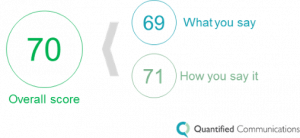 It's only a matter of time until artificial intelligence is a decision maker in every workplace. Although the term may still conjure up sci-fi images of robots gone rogue, AI is actually far less terrifying. With it, computer systems can complete or assist in tasks that would require human intelligence---at a much larger scale than we could on our own---in fields that include speech recognition, visual perception and decision-making. That could mean robots, yes, but AI is more than that. When Amazon offers recommendations based on your browsing history, that's artificial intelligence. When your thermostat adjusts the temperature automatically to help you save money, that's AI. Siri, Google Now and Cortana are too. It's understandable that AI has caused unease among those who fear it may render their jobs obsolete. As technology has progressed and the scope of AI has expanded, so has the tension between art and science. Many communication professionals have grown to fear a future in which robots may edge them out of their work. But what if AI, rather than making some professionals obsolete, could actually make their jobs easier? In the leadership communication industry, that's exactly what's happening.
It's only a matter of time until artificial intelligence is a decision maker in every workplace. Although the term may still conjure up sci-fi images of robots gone rogue, AI is actually far less terrifying. With it, computer systems can complete or assist in tasks that would require human intelligence---at a much larger scale than we could on our own---in fields that include speech recognition, visual perception and decision-making. That could mean robots, yes, but AI is more than that. When Amazon offers recommendations based on your browsing history, that's artificial intelligence. When your thermostat adjusts the temperature automatically to help you save money, that's AI. Siri, Google Now and Cortana are too. It's understandable that AI has caused unease among those who fear it may render their jobs obsolete. As technology has progressed and the scope of AI has expanded, so has the tension between art and science. Many communication professionals have grown to fear a future in which robots may edge them out of their work. But what if AI, rather than making some professionals obsolete, could actually make their jobs easier? In the leadership communication industry, that's exactly what's happening.
AI in communication
Starting in grade school, there's a perception that you can be great at math and science or great at writing and speaking, but not both. But we've seen that artificial intelligence is enabling people to approach creative endeavors in a way that resembles math, blurring the line between art and science. According to Ray Kurzweil, one of the best-known AI thinkers, this creative process begins with "hybrid thinking," an interplay between human and cyber intelligence that he sees as the next big leap in thinking, and it even goes so far as Google researchers' attempts to quantify the ultimate art: art. So as the machines get smarter, we can begin to measure and track human behavior in ways that were never before possible. (For further thinking here, we are big fans of Sandy Pentland at MIT Media Lab.) AI can be used to help leaders improve the way they communicate. Conceptually, it's not overly complex. If you can train machines to identify what makes an audience react (trust, engage, listen, act) and then train the machine to measure enough factors in those communications (how we use our words, voices, gestures) that may create those reactions, then you can use data science and algorithms to build an intelligent machine that can improve how we communicate. For example, we train our machine (analytics platform) on the factors that make someone a great leadership communicator, what makes someone trustworthy, etc., and then we help people "optimize" their communication on those factors. The goal of any communication, whether it's a letter to shareholders or a keynote address, is to influence the audience in some way. As we prepare to deliver key messages, the question on our minds is always, Will this work? Will this have the desired effect on my audience? With enough resources invested in test audiences, focus groups, and certain media monitoring platforms, you may begin to get an answer to that question. Unfortunately, these costly, time-consuming methods are out of the realm of possibility for many companies, and most individuals. However, developments in technology and data science have led to a new kind of AI where you can simulate an audience, empowering you to identify in an objective and efficient way how your message and delivery will land.
What you say: How will your content resonate with your audience?
Using natural language processing---translating human communication into the computer's processing language---we can conduct automated content evaluations. The AI uses algorithms built from years of audience perception and communication research to analyze your content on a wide range of characteristics. How trustworthy will your audience perceive your message to be? Will they find it to be clear? Engaging? More clear and engaging than your competitor's latest presentation?
How you say it: How will your delivery affect their impression of you?
Similar technology enables the AI to evaluate how an audience will respond to the way you deliver your message---your tone of voice, speech rate, facial cues and body language. Will your gestures make you appear confident or nervous? Will your tone convey topic mastery?  The data-driven insights the AI provides on the quality and effectiveness of your communication are fully customizable, allowing you to tailor your feedback to the needs of your audience and to the purpose of your engagement. Imagine being able to pinpoint your specific strengths and development areas right away---without having to wait for survey results or wonder whether your test audience was truly objective. What's more, you can use the same process to measure other communicators---your peers, your competitors, your entire industry---at the same time, to find out exactly how you compare.
The data-driven insights the AI provides on the quality and effectiveness of your communication are fully customizable, allowing you to tailor your feedback to the needs of your audience and to the purpose of your engagement. Imagine being able to pinpoint your specific strengths and development areas right away---without having to wait for survey results or wonder whether your test audience was truly objective. What's more, you can use the same process to measure other communicators---your peers, your competitors, your entire industry---at the same time, to find out exactly how you compare.
The future
What's the next step? The AI's data-driven insights already make our feedback, rehearsal and revision processes much easier. But what if it could do more? What if AI could pair those insights with automated recommendations based on your greatest development opportunities? What if it could build an action plan to help you achieve the greatest improvement in the smallest amount of time? In their research "An Executive's Guide to Machine Learning," McKinsey & Company identified the three phases of AI as description, prediction and prescription. As the AI continues to evolve, (human-supervised) machine learning will empower it to arm coaches, speakers, and writers with more than just descriptive insights and predictive measures---it will begin to play a major role in the improvement process itself.
Virtual reality in the rehearsal room
When we prepare to give a speech, we can rehearse in front of family members, friends, and coaches to practice speaking to an audience. We can rehearse in noisy areas to practice powering through distraction. But the rehearsal room can only take us so far. Virtual reality may change that. As these platforms continue to become more immersive and more accessible, speakers will have the opportunity to simulate speaking in their presentation space, in front of a packed audience. Speakers and their coaches will be able to recreate multiple rehearsal environments such as a lecture hall, a conference room, or even the TED stage. Users can leverage this technology to practice interacting with an unpredictable audience, and to become comfortable presenting in the room.
Enhancing, not erasing
Let's be clear. We're not counting down the days until communication experts, editors, and public speaking coaches become obsolete. We're celebrating the ways artificial intelligence has, and will, make their jobs easier and their methods more efficient. Our own communication analysts and coaches have already embraced these new developments, reinforcing their own subjective instincts and expertise to guide clients with objective data that represents an audience of millions. This method is more expansive and more objective than any focus group, and it allows coaches to present a clear view of how their particular audience will react to the speaker's message. Briar Goldberg from our team shares the value she sees in applying AI to communication. She can create stronger personal relationships with her clients when the AI is delivering the tough love: "Now, with objective data, the more difficult messages feel less personal, less confrontational, which, as a coach, allows me to build my relationships from solutions and progress." One more reason for communication professionals to adopt artificial intelligence: Studies show that even though we spend up to 80 percent of our waking hours communicating, we're conscious of only 5 to 20 percent of the signals we're sending others. Shouldn't we be seeking out as many tools as possible to make sure our most important messages are being heard?
Check out Noah Zandan's IABC member-only webinar, The Future of Human Communication, to learn more.